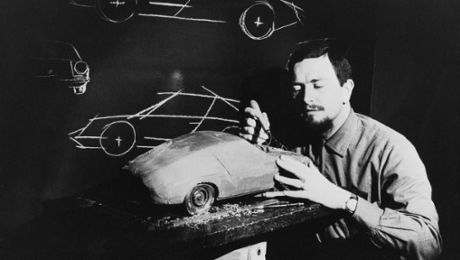The “Consistent” Idea
Porsche design DNA extends across all model ranges – and that of the 911 goes all the way back to 1963. Visitors can experience the design DNA interactively. The “Consistent” station features six car models on turntables, one derivative for each model line. The exhibit combines classic exhibition furniture with 3D printing methods and optical sensor technology. When a visitor approaches the interactive turntable, all cars stop their pause loop and turn to face the visitor. As soon as the turntable under the 911 moves, the other Porsche rotate in sync. Meanwhile, red illuminated lines appear on all six models, which provide a visual depiction of the Porsche design DNA, and which are explained in detail on the Multimedia Guide. Rarely has it been easier to visualise the relationships between the model ranges by means of design lines. The interactive exhibition furniture is an established fixture of the permanent exhibition – in addition to the 80 cars and more than 200 small exhibits.
The “Passionate” Idea
Porsche engineers seek out new challenges every day. On all race tracks. And they celebrate successes. In all races. Whoever wins Le Mans, the Mille Miglia, the Paris-Dakar, the Carrera Panamericana, on the Nürburgring, in Monte Carlo and in Sebring is equipped for every situation.
The “Passionate” idea therefore represents the emotional side of motorsport. For Porsche, motorsport is the starting point for new developments and improvements to production models, but it also encapsulates success, triumphs and emotions. The unique passion of the company and its engineers, mechanics, drivers and fan community is expressed in over 30,000 race victories. The fascination of motorsport is impossible to evoke through technical exhibits alone. Emotionally charged symbols such as the historic starting flag for the 24 Hours of Le Mans and over 150 winner’s trophies are therefore displayed alongside legendary race cars to convey the “Passionate” idea to visitors.
The “Powerful” Idea
Porsche enjoyed unprecedented success in motor racing in the early 1970s. The Zuffenhausen company dominated all its competitors. This emboldened its confidence in its technical abilities.
Having long led the way in lightweight construction, Porsche now also started to build the most powerful engines. In this part of the exhibition, the thematic focus is therefore on high-performance engines and their design. In motor racing this was the heyday of the Porsche 917, whose power unit is presented to the visitor in depth.
The exhibit is a twelve-cylinder boxer engine stripped down to its component parts. This engine generation culminated in the most powerful Porsche ever, in the guise of the 1,200 turbo PS engine that featured in the 917/30 in 1973. The power-boosting technologies developed for these races were successfully translated to road-going sports cars. The turbo engine in the 911 Turbo – the reference exhibit for the product’s history – proceeded to enjoy an illustrious career. “Turbo” thus becomes synonymous with Porsche technology.
The “Fast” Idea
The key topics of the “Fast” idea are aerodynamics and the vehicle’s controllability. Engine power alone is ineffective if it cannot be harnessed. From the very outset, Ferry Porsche therefore sought to make his cars both controllable and aerodynamic – and therefore faster.
Optimised aerodynamics are one of the decisive factors in making a car fast. In 1973, the 911 Carrera RS 2.7 Coupé with its distinctive “duck tail” rear spoiler was therefore the fastest German-built road car with a top speed of 240 km/h.
In the motor racing world, the ultimate test of speed and endurance is Le Mans. This 24-hour race can be won only by those capable of building a robust car with a high top speed. On the long Mulsanne Straight, top speed matters more than in virtually any other race. Thanks to its great aerodynamic expertise – exemplified by famous winning cars – Porsche has achieved numerous class wins and no fewer than 19 overall victories. It therefore also still holds the lap record, set by the Porsche 917 KH in 1971, with 5,335 kilometres clocked up at an average speed of 222 km/h. The key technical exhibit illustrating the “Fast” idea is the Porsche 956, which is suspended spectacularly above visitors’ heads. This demonstrates that the car could theoretically drive on the ceiling at a speed of 321.4 km/h.
The “Clever” Idea
Porsche seeks to respond to technological challenges with the best rather than the quickest solution. The “Clever” idea therefore represents Porsche’s engineering skills.
Since 1971, the sports car manufacturer’s engineers have been developing and optimising technical solutions at the Research and Development Centre in Weissach. They carry on the tradition of the attention to technical detail first nurtured by Ferdinand Porsche. The Porsche Ceramic Composite Brake (PCCB), VarioCam valve control and the Porsche Doppelkupplung (PDK) dual-clutch transmission are just a few examples of the technologies developed by Porsche. The Porsche 356 B 2000 GS Carrera GT already featured a locking-synchromesh gearbox as far back as 1960, for example.
The “Light” Idea
The power-to-weight ratio has always been the crucial factor in sports car manufacturing – in other words, the relationship between the engine power and vehicle weight. For that reason, Porsche has always been committed to reducing weight and to lightweight design principles.
The “Light” idea presents lightweight construction as a core competence of Porsche. Porsche’s race cars were superior and triumphant in the Targa Florio, the famous endurance race in the mountains of Sicily, mainly thanks to their light and agile designs. The 356 America Roadster was already the lightest Porsche of its time. This philosophy is encapsulated by the internally illuminated, ultra-thin plastic fibre body of the short-tail Porsche 908 Coupé from 1968, which tipped the scales at a mere 130 kilograms.


